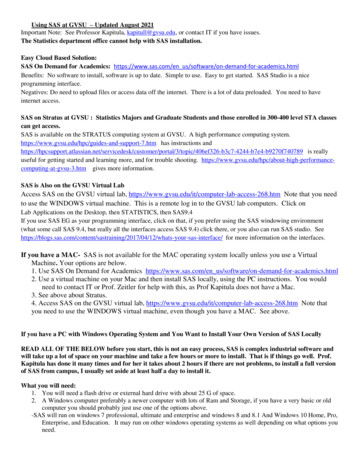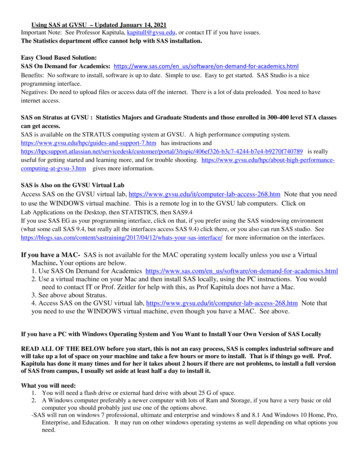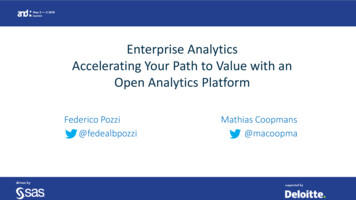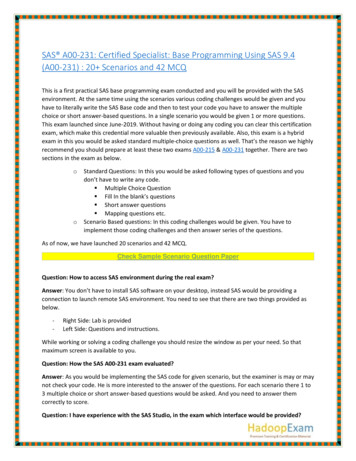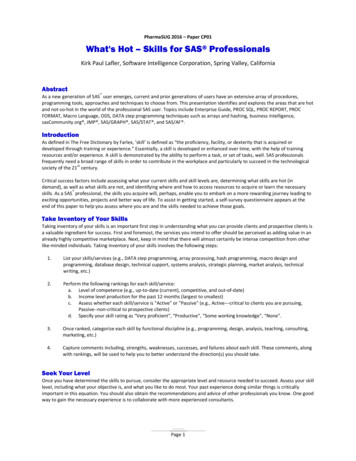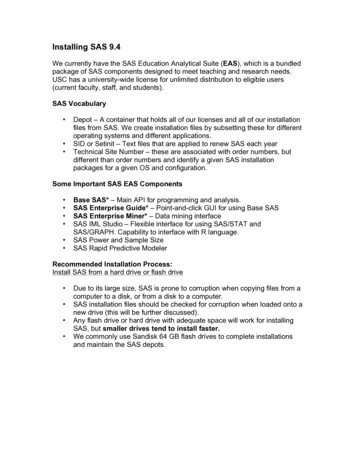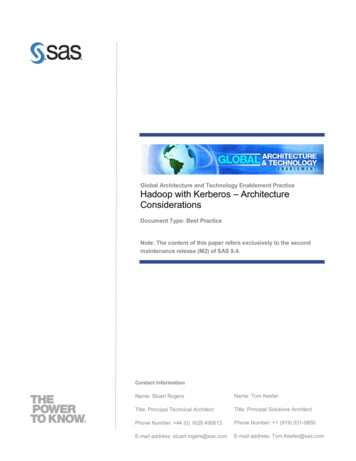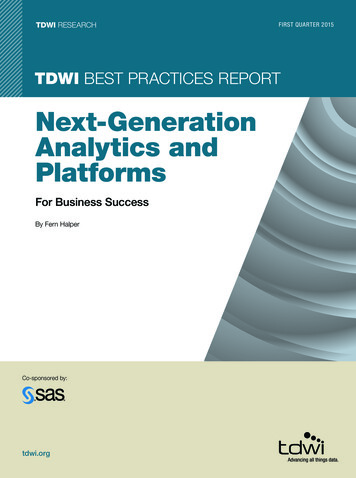
Transcription
TDWI RESEARCHFIRST QUARTER 2015TDWI BEST PRACTICES REPORTNext-GenerationAnalytics andPlatformsFor Business SuccessBy Fern HalperCo-sponsored by:tdwi.org
TDWI researchBEST PRACTICES REPORTNext-GenerationAnalytics andPlatformsFor Business SuccessBy Fern HalperFirst Quarter 2015Table of ContentsResearch Methodology and Demographics . . . . . . . . . . . . . 3Executive Summary . . . . . . . . . . . . . . . . . . . . . . . . . 4Introduction to Next-Generation Analytics Technologies . . . . . 5What Is Next-Generation Analytics? . . . . . . . . . . . . . . . . 5In Their Own Words . . . . . . . . . . . . . . . . . . . . . . . . . 5Trends Supporting Next-Generation Analytics . . . . . . . . . . . 6Drivers for Next-Generation Analytics . . . . . . . . . . . . . . . 7Next-Generation Analytics Status . . . . . . . . . . . . . . . . . . 7BI Status . . . . . . . . . . . . . . . . . . . . . . . . . . . . . . 8The Status of More Advanced Analytics . . . . . . . . . . . . . . 9Gimme the Data! . . . . . . . . . . . . . . . . . . . . . . . . . 11Where Is It Being Used? . . . . . . . . . . . . . . . . . . . . . . 12Who Is Using It? . . . . . . . . . . . . . . . . . . . . . . . . . . 14Technologies That Support Next-Generation Analytics . . . . . . 15Platforms . . . . . . . . . . . . . . . . . . . . . . . . . . . . . 15Platform Status . . . . . . . . . . . . . . . . . . . . . . . . . . 16The Cloud . . . . . . . . . . . . . . . . . . . . . . . . . . . . . 17Open Source . . . . . . . . . . . . . . . . . . . . . . . . . . . . 19Operationalizing Analytics: The Path to Action . . . . . . . . . . 19The Status of Operational Analytics . . . . . . . . . . . . . . . . 19Analytics Informs Action . . . . . . . . . . . . . . . . . . . . . . 20Challenges and Emerging Best Practices forNext-Generation Analytics . . . . . . . . . . . . . . . . . . . . . 21Overcoming the Challenges . . . . . . . . . . . . . . . . . . . . 22Acquiring Skills . . . . . . . . . . . . . . . . . . . . . . . . . . 23Other Best Practices . . . . . . . . . . . . . . . . . . . . . . . . 23Measuring the Value of Next-Generation Analytics . . . . . . . . 24 2014 by TDWI, a division of 1105 Media, Inc. All rights reserved.Reproductions in whole or in part are prohibited except by writtenpermission. E-mail requests or feedback to info@tdwi.org.Product and company names mentioned herein may be trademarksand/or registered trademarks of their respective companies.Vendor Platforms and Tools That SupportNext-Generation Analytics . . . . . . . . . . . . . . . . . . . . . 25Top Ten Best Practices . . . . . . . . . . . . . . . . . . . . . . . 27tdwi.org 1
Next-Generation Analytics and PlatformsAbout the AuthorFern Halper is well known in the analytics community, having published hundreds of articles,research reports, speeches, Webinars, and more on data mining and information technology overthe past 20 years. Halper is also co-author of several “Dummies” books on cloud computing, hybridcloud, and big data. She is the director of TDWI Research for advanced analytics, focusing onpredictive analytics, social media analysis, text analytics, cloud computing, and “big data” analyticsapproaches. She has been a partner at industry analyst firm Hurwitz & Associates and a lead analystfor Bell Labs. Her Ph.D. is from Texas A&M University. You can reach her at fhalper@tdwi.org, onTwitter @fhalper, and on LinkedIn at www.linkedin.com/in/fbhalper.About TDWITDWI is your source for in-depth education and research on all things data. For 20 years, TDWIhas been helping data professionals get smarter so the companies they work for can innovate andgrow faster.TDWI provides individuals and teams with a comprehensive portfolio of business and technicaleducation and research to acquire the knowledge and skills they need, when and where they needthem. The in-depth, best-practices-based information TDWI offers can be quickly applied to developworld-class talent across your organization’s business and IT functions to enhance analytical, datadriven decision making and performance.TDWI advances the art and science of realizing business value from data by providing an objectiveforum where industry experts, solution providers, and practitioners can explore and enhance datacompetencies, practices, and technologies.TDWI offers five major conferences, topical seminars, onsite education, a worldwide membershipprogram, business intelligence certification, live Webinars, resourceful publications, industry news,an in-depth research program, and a comprehensive website: tdwi.org.About the TDWI Best Practices Reports SeriesThis series is designed to educate technical and business professionals about new business intelligencetechnologies, concepts, or approaches that address a significant problem or issue. Research for thereports is conducted via interviews with industry experts and leading-edge user companies and issupplemented by surveys of business intelligence professionals.To support the program, TDWI seeks vendors that collectively wish to evangelize a new approachto solving business intelligence problems or an emerging technology discipline. By banding together,sponsors can validate a new market niche and educate organizations about alternative solutions tocritical business intelligence issues. To suggest a topic that meets these requirements, please contactTDWI Research Directors Philip Russom (prussom@tdwi.org), David Stodder (dstodder@tdwi.org),or Fern Halper (fhalper@tdwi.org).SponsorsActian, Cloudera, Datawatch Corporation, Pentaho, SAP, and SAS sponsored the research forthis report.2 TDWI research
Research Methodology and DemographicsResearch Methodology andDemographicsPositionData analyst/scientistor business analystReport Scope. Analytics has become extremely important to business. Manyorganizations are on the cusp of moving from reporting and dashboards to newerforms of analytics. The result is that companies are looking for a way to driveinsight and action using analytics without becoming mired in analytics andinfrastructure issues. The purpose of this report is to accelerate understandingof the many new technologies and practices that have emerged recently aroundanalytics.Research Methods. In addition to the survey, TDWI Research conducted telephoneinterviews with technical users, business sponsors, and experts. TDWI alsoreceived product briefings from vendors of products and services related to the bestpractices under discussion.Survey Demographics. There was a good mix of survey respondents includinganalysts/scientists and business analysts (24%), business sponsors or users(20%), executives (20%), IT developers (20%), and consultants (11%). We askedconsultants to fill out the survey with a recent client in mind.The consulting industry (18%) dominates the respondent population, followedby software/Internet (11%), financial services (10%), and healthcare (10%). Mostrespondents reside in the U.S. (51%), Europe (17%), or Asia (11%). Respondentsare fairly evenly distributed across all sizes of company.AcknowledgmentsTDWI would like to thank many people who contributed to this report. First,we appreciate the many users who responded to our survey, especially those whoresponded to our requests for phone interviews. Second, our report sponsors, whodiligently reviewed outlines, survey questions, and report drafts. Finally, we wouldlike to recognize TDWI’s production team: Michael Boyda, Roxanne Cooke,Marie Gipson, Denelle Hanlon, and James Powell.BI sponsor20%Executive20%IT ing/professional servicesSurvey Methodology. In late July 2014, TDWI sent an invitation via e-mailto business and IT executives; VPs and directors of BI, analytics, and datawarehousing; business and data analysts; data scientists; IT application managers;and other BI/DW professionals, asking them to complete an Internet-based survey.The invitation was also delivered via websites, newsletters, and publications fromTDWI. The survey drew over 450 responses. From these, we excluded incompleteresponses as well as some respondents who identified themselves as vendors oracademics. The resulting 328 responses form the core data sample for this report.24%Software/Internet11%Financial e6%Insurance6%Computer manufacturing4%Government4%Manufacturing her” consists of multiple industries, eachrepresented by less than 3% of respondents.)Region51%United States17%EuropeAsia11%Canada6%Australia/New Zealand6%Mexico, Central or S. America5%Africa2%Middle East2%Company Size by Revenue16%Less than 100 million 100– 500 million7% 500 million– 1 billion5%23% 1– 10 billionMore than 10 billion17%21%Unable to discloseDon’t know11%Based on 328 survey respondents.tdwi.org 3
Next-Generation Analytics and PlatformsExecutive SummaryThe market is on thecusp of moving forward.User organizations are pushing the envelope in terms of analytics and the platforms to supportanalysis. These organizations realize that to be competitive, they must be predictive and proactive.However, although the phrase “next-generation platforms and analytics” can evoke images ofmachine learning, big data, Hadoop, and the Internet of things, most organizations are somewherein between the technology vision and today’s reality of BI and dashboards. Next-generationplatforms and analytics often mean simply pushing past reports and dashboards to more advancedforms of analytics, such as predictive analytics. Next-generation analytics might move yourorganization from visualization to big data visualization; from slicing and dicing data to predictiveanalytics; or to using more than just structured data for analysis. The market is on the cusp ofmoving forward.Predictive analytics,geospatial analytics,text analytics, and evenin-stream analysis arepoised to double in usein the next three years.Although the majority of our survey respondents use some kind of analytics software against theirdata warehouse or a commercial analytics package on their server, they show great interest in movingahead with more advanced forms of analytics and the infrastructure to support it. Technologies suchas predictive analytics, geospatial analytics, text analytics, and in-stream analysis are all poised todouble in use over the next three years if users stick to their plans. Additionally, more than 50% ofour survey respondents are already using an analytics platform or appliance. They are looking atother platforms, too, such as in-memory databases, analytics, and in-memory computing. They areexploring (and using) the cloud. There are challenges, too: More than half of respondents cite skillsas their top challenge, followed by the closely related challenge of understanding the technology.For companies that are making use of more advanced analytics, the results are rewarding. Theseenterprises are monitoring and analyzing their operations and predicting and acting on behaviorsof interest. They are measuring top- and bottom-line impacts. In fact, about a quarter of the surveyrespondents are already measuring this impact. These respondents are more likely to use advancedanalytics and disparate data types. They are building a coordinated data ecosystem. There is no silverbullet to get there, but these companies are making it happen.This TDWI Best Practices Report focuses on how organizations can and do use next-generationanalytics. It provides in-depth analysis of current strategies and future trends for next-generationanalytics across both organizational and technical dimensions, including organizational culture,infrastructure, data, and processes. It examines both the analytics and infrastructure necessary fornext-generation analytics. This report offers recommendations and best practices for implementinganalytics in an organization.4 TDWI research
Introduction to Next-Generation Analytics TechnologiesIntroduction to Next-Generation AnalyticsTechnologiesAnalytics has attracted considerable market excitement. Recent research finds that companies usinganalytics for decision making are 6% more profitable than those that do not.1 Companies understandthe value of analytics; they want to be predictive and proactive, and advanced analytics is rapidlyemerging as a big part of the analysis landscape. Additionally, as businesses realize that theirtraditional data warehouse can be insufficient for their analytics and performance needs, they arelooking for new ways to easily access and analyze growing volumes of disparate data—oftenincorporating their existing data management infrastructure.Companies thatuse analytics fordecision making aremore profitable.Next-generation infrastructure such as analytic platforms and appliances are important in thisevolving ecosystem, as are open source systems such as Hadoop. Unified information architecturesare becoming a part of the picture as is the cloud. On the analytics front, businesses are looking toincorporate what they are using today as well as newer technologies (such as text analytics, streammining, geospatial analytics, big data analytics) and more-established forms of advanced analytics(such as predictive analytics) over this infrastructure.What Is Next-Generation Analytics?What, exactly, is next-generation analytics? Is it only the newer analytics techniques? For this report,we consider analytics beyond the basics of BI reporting and dashboards. This includes explorationand discovery (often on big data) utilizing easy-to-use software and more advanced analytics (such aspredictive analytics or stream mining) as well as new ways of approaching analytics, such asvisualizing vast amounts of real-time data. In fact, visualization for data discovery and/or predictiveanalytics is often a first stepping stone to more advanced analytics. Next-generation analytics alsoincludes the supporting infrastructure (such as Hadoop and other analytic platforms). Thedeveloping analytics ecosystem can be quite complex.Next-generationanalytics is thesuccessor to BI reportingand dashboards.In Their Own WordsWe asked respondents to provide examples of forward-looking analytics deployments in theirorganizations. We wanted to understand how the respondents were thinking about “next generation.”About 20% could not provide an example, including a fraction who said the example would be tooproprietary to share. For those who responded, some examples were more traditional and some werenewer. For instance, use cases included forecasting, predicting human (e.g., customers or patients)behavior as well as machine behavior. Some next-generation examples include: Healthcare: Predicting expected patient re-admittance to hospital, predicting expected visits toemergency rooms, and patient monitoring Insurance: Predicting future claim rates to price insurance risk Financial services: Fraud monitoring Energy: Real-time analytical processing of oil well data Horizontal: Market basket analysis, segmenting customers, churn analysis, predictingequipment failure Forecasting world events1Andrew McAfee and Erik Brynjolfsson [2012]. “Big Data: The Management Revolution,” Harvard Business Review, October.tdwi.org 5
Next-Generation Analytics and PlatformsNext-generationanalytics ishappening now.Although some of these are examples that vendors in the market have been talking about for years,what is important is that companies are actually performing these kinds of analyses now.Trends Supporting Next-Generation AnalyticsSeveral trends have helped to both motivate and drive organizations to utilize next-generationanalytics, including the following: Ease of use. In the past, building a predictive model required a scripting or programminglanguage. Now, vendors generally provide a drag-and-drop or point-and-click interface. Somevendors have gone so far as to have their software ingest the data, determine the outcomevariables, and suggest which model is best. Some automatically run a model. Many vendorshave also provided collaboration features to allow a non-technically skilled user to build a modeland share it with a more experienced person for feedback. Some companies require this in orderto put a model into production. Such features make it easier for individuals to build models,elevating business analysts to some of the primary builders of models. Democratization. The idea behind democratization is to provide all people access to data,regardless of technical prowess, to help make more informed decisions. This is tied to the easeof-use trend mentioned earlier. Originally, democratization focused on self-service BI for reportsand dashboards. Now it also includes visualization as well as more advanced techniques. Consumerization. Consumability means either (1) BI or analytics can be utilized easily bymany people—(related to democratization) or (2) that the results of BI or analytics can beconsumed by the masses. In the latter case, embedding a model into a business process mightbe necessary. For instance, as a credit card transaction comes into a retail system, it might bescored for probability of fraud and routed to a special investigation unit. This is an example ofoperationalized analytics (we discuss operationalizing analytics later in this report) in whichmore people can make use of the analysis. In other words, someone might build a model thatmany people utilize. Platforms. Analytic platforms—software that provides an integrated solution for the analyticslife cycle—is also gaining popularity. This next generation infrastructure can help make moreadvanced analytics easier to build and deploy. In a 2013 TDWI Best Practices Report2 onpredictive analytics, 83% of survey respondents stated that they would be using an analyticsplatform in the next three years. Big data and the Internet of things. Big data—ever-increasing amounts of disparate data at varyingvelocities—is important because it can drive value. Disparate data is being generated at largescale and high speed. The Internet of things (IoT) brings home the big data value proposition.As sensors and machines generate vast amounts of near- and true real-time data, organizationsare beginning to use this data for applications ranging from real-time operational intelligenceof a manufacturing facility to patient monitoring. Big data is also driving the use of newerinfrastructure such as Hadoop and multi-platform data warehouse environments that manage,process, and analyze new forms of big data, non-structured data, and real-time data. Thismight include NoSQL databases, data warehouse appliances, and columnar databases. Othertechnologies, such as machine learning, are gaining steam because of big data from the IoT.Use cases for machine learning include predictive analytics. With big data, that might meanthousands of attributes, and organizations might use machine learning to first figure out thekey variables because a predictive model with a thousand attributes might reflect more noiseand error than real relationships.6 TDWI research2See the 2013 TDWI Best Practices Report Predictive Analytics for Business Advantage, available at tdwi.org/bpreports.
Next-Generation Analytics StatusDrivers for Next-Generation AnalyticsThe market for next-generation platforms and analytics is growing for many reasons, but what are thedrivers for user adoption of the technology? We asked respondents to score the important drivers ofnext-generation analytics on a five-point scale where 1 was extremely unimportant and 5 wasextremely important.Decision making, understanding customers, and improving business performance ranked at the top. Companiesare interested in utilizing analytics to make decisions. More often than not, they start with analyticsto understand some behavior. Over 50% of the respondents (not charted) stated that using nextgeneration analytics is extremely important for driving strategic decision making and understandingcustomers. Slightly less than 50% felt it was extremely important for improving businessperformance and processes (not charted).Over 50% of respondentsstated that using nextgeneration analytics wasimportant for strategicdecision making.Drive new revenue: Respondents are interested in next-generation analytics to help drive new revenueopportunities, whether for sales and marketing or other business opportunities. Forty-six percent(not charted) of respondents felt this was extremely important.Lower on the list was driving real-time actions. Analytics is useful only when acted upon. However, muchof the market is not yet mature enough to implement real-time actions or take action on real-timeevents—a familiar situation from previous research (for instance, see the 2014 TDWI Best PracticesReport Real-Time Data, BI, and Analytics3) as well. Likewise, monetizing analytics (i.e., generatingrevenue by actions such as selling analytics services) also ranked low. Fewer than 25% of respondentscite these drivers as extremely important.Next-Generation Analytics StatusAs pointed out earlier, the emerging analytics ecosystem consists of software, infrastructure, andmethodologies. Gone are the days when the data mart or data warehouse or flat files could handleeverything a company needed to do for analysis. Instead, forward-looking organizations arebeginning to take an ecosystem approach to infrastructure, with different tools for different tasks.To understand what tools and techniques are being used today, and which are poised for growth, weinvestigated the status of BI, analytics, and technologies.3Available at tdwi.org/bpreports.tdwi.org 7
Next-Generation Analytics and PlatformsBI StatusDashboards are verycommon today: 83% ofrespondents use them.To learn about respondents’ status in terms of BI and analytics, we asked, “What kinds of BI do youperform in your company today? Three years from now?” (See Figure 1.)What kinds of BI do you perform in your company today? Three years from now?Using today and will keep usingPlanning to use within next 3 yearsDashboards49%Data discovery48%Forecasting47%17%7% 4%11%12%37%9% 5%35%10%39%40%14%45%35%7%9% 5%38%35%31%3227%60%Self-service BI2220%62%Descriptive analysisRisk analysis13%75%VisualizationReal time reportingDon’t know83%Dashboards with KPIs and metricsContinuous monitoring and alertingNo plans8%14%24%6%10%Figure 1. Types of BI in use at respondent companies. Based on 328 respondents.Dashboards are the most commonly used BI technology today. Dashboards rank at the top of the list withclose to 83% of respondents stating they use dashboards today. TDWI has seen similar results inother research. Seventy-five percent of respondents answered that dashboards with KPIs and metricsare being used today. Dashboards are a popular technology that helps users get an idea of what ishappening, or, more likely, what has already happened in their business. Dashboards are not nextgeneration technology, but they can help people think analytically, which can drive next-generationapproaches.Visualization is becomingincreasingly popular.Visualization and self-service are primed for growth. Visualization has become a popular technique for dataexploration and discovery; its use is exploding. Visualization can help business analysts and others inthe organization to slice and dice and discover patterns in their data4. In our survey, 62% ofrespondents are already using visualization, and another 27% are planning to utilize it in the nextthree years. Visualization can become complex internally for pattern detection and exploration ofmultiple data sources, including real-time ones.Continuous alerting and monitoring is also poised for expansion. Although taking action did not scoreextremely high on the list of next-generation drivers, continuous alerting and monitoring is poisedfor growth. Forty percent of the respondents utilize it today and an additional 38% expect to do soin the next three years. This is actually a strong step toward next-generation analytics. Monitoringand alerting might not happen on a true real-time scale—for example, daily or hourly is the norm formany organizations5 —but it is forward movement (from the thought-process perspective) in termsof automating analytics or embedding analytics into a business process or system. We discuss this inmore detail in the operationalizing analytics section beginning on page 19.8 TDWI research4For more information on visualization and self-service BI, see the 2014 TDWI Best Practices Report Business-Driven Business Intelligenceand Analytics available at tdwi.org/bpreports.5For more information on real time, see the 2014 TDWI Best Practices Report Real-Time Data, BI, and Analytics available at tdwi.org/bpreports.
Next-Generation Analytics StatusThe Status of More Advanced AnalyticsWe also asked respondents about the status of more advanced analytics in their organizations. Thesetechnologies include: Predictive analytics: A statistical or data mining technique that can be used on both structuredand unstructured data to determine outcomes such as whether a customer will “leave or stay” or“buy or not buy.” Predictive analytics models provide probabilities of certain outcomes. Popularuse cases include churn analysis, fraud analysis, and predictive maintenance.Predictive analytics isoften a first step in nextgeneration analytics. Prescriptive analytics: Whereas predictive analytics helps users determine what might happen,prescriptive analytics goes further to either suggest or automatically initiate a subsequent actionto produce an optimal result. For instance, prescriptive analytics in healthcare can be usedto guide clinician actions by making treatment recommendations based on models that userelevant historical intervention and outcome data. Prescriptive analytics can use both predictiveanalytics and optimization to do this. True prescriptive analytics often utilizes constraints. Geospatial analytics: This form of analytics involves manipulating and analyzing geospatialdata, often called location or spatial data. This includes geocoded, remote-sensing, and GPSdata. Geospatial analytics includes statistical techniques as well as techniques designed forspatial and spatial/temporal data. For instance, in industrial analytics, a large-scale, discretemanufacturer might use geospatial data to analyze manufacturing bottlenecks in real time. Aretailer might use geospatial analytics to examine customer data it is already collecting to planthe location of its next store. Text analytics: Text analytics is the process of analyzing unstructured text, extracting relevantinformation, and transforming it into structured information that can be leveraged in variousways. Text analytics can be used on a range of text from e-mail messages to social media tounderstand the “why” behind the “what.” For instance, if a customer discontinues a service, textanalytics can help to understand the reasons for the action. Were they unhappy? Why? Operational intelligence (OI): This analytics technique involves using query analysis or othermore advanced analytics against continuous, potentially real-time or near-real-time data to gainvisibility into operations. Operational intelligence can go hand in hand with the Internet ofthings. OI could be used to evaluate complex event processing for oil well operations.When we asked if respondents thought they were performing advanced analytics, 44% answeredaffirmatively (not charted). Another 39% said they are planning to in the next two years.Additionally, 33% of respondents said they are already performing big data analytics, and another33% are planning to begin over the next year or two (not charted).44% of respondentsare already performingadvanced analytics.What are these respondents doing now and what are they planning to do? There are a range ofadvanced analytics being used now as well as being planned for in the future.Time-series analysis, operational intelligence, and quality monitoring all rank high. These three technologiesranked at the top of the list of more advanced analytics (See Figure 2) in terms of current usage.More than 40% of respondents stated they use each of these technologies. Operational intelligenceand quality monitoring are related in that they both analyze some kind of continuous stream ofdata. Of course, the data might have varying time frequencies that may not be short. Time-seriesanalysis has been utilized for many years, and some people will use it for forecasting. However, timeseries analysis is also becoming more popular in terms of real-time and near-real-time analysis ofcontinuous data streams.tdwi.org 9
Next-Generation Analytics and PlatformsPredictive analyticsadoption may double inthe next three years.Predictive analytics is poised for significant growth. Predictive analytics is rapidly gaining attention in themarket, as reflected in the percentage of respondents using the technology today. It is also poised forsignificant growth (See Figure 2). Thirty-nine percent of respondents are currently using predictiveanalytics today and an additional 46% are planning to use it in the next few years. Predictiveanalytics is often an important first step for companies embarking on next-generation analytics.Interestingly, 23% of respondents stated that they use prescriptive analytics already, a number thatseems high. It could be that many of the
the past 20 years. Halper is also co-author of several "Dummies" books on cloud computing, hybrid cloud, and big data. She is the director of TDWI Research for advanced analytics, focusing on predictive analytics, social media analysis, text analytics, cloud computing, and "big data" analytics approaches.
